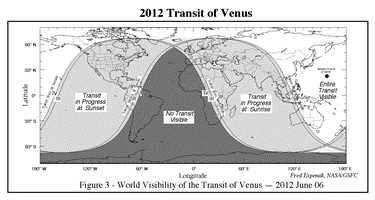|
The Transit of
Venus - June 5, 2012
An Observing Project in Canada's Northwest Territories
Why the
Northwest Territories?
"To see the entire
transit, travel to Canada’s northern regions is required.
Yellowknife offers the most promising cloud and sunshine
statistics of any northern site, Europe or North America, with
sunshine hours averaging 64 percent of the maximum – and you can
drive there." - Jay Anderson
| The map on the right shows the
world visibility of the 2012 Transit of Transit. As the
transit occurs in June, summertime in the northern hemisphere,
the extreme northern latitudes of the world will be able to
observe the whole transit during the long days (the Midnight
Sun, the White Nights).
Click on
the map or
here for a full-size version. The red dot on
the full-size map indicates the location of Yellowknife, Northwest Territories.
Meteorologist Jay Anderson,
quoted above, favours Yellowknife for observing the complete
Transit from North America. For a quick link to Jay's
site, clink
here. |
 |
Commentary:
The next Transit of Venus occurs in 2117, beyond our lifetimes,
so this 5 June 2012 is the last chance to observe this
phenomena. We encourage you to see it from wherever you
can. Undoubtedly central and eastern Australia offer the
best weather prospects for the Transit, followed by the
favourable aspects and weather in Hawai'i (our prior choice).
Visibility in the United States Southwest should be
exceptionally good, but the region does not see the whole
Transit from start to finish. Tahiti has the historical
connection to Cook's voyage to observe the Transit of 1769 and
would be very interesting, but misses the whole Transit this
time.
If you want to see the whole transit from North America
or Europe than you have to travel to the far northern reaches to
do so. And Yellowknife, NWT, Canada has the best weather
prospects for observing the whole Transit of any northern site
according to Jay Anderson.
But there may be other reasons to observe the transit
from Yellowknife. First, one can drive to Yellowknife in
15 hours from Edmonton, Alberta, and enjoy interesting scenery
and wildlife along the way. If driving up here then check
the travel section of these pages.
Second, if driving up then one can bring substantially more
equipment than flying to another location at greater cost.
Third, cost containment. With the annular solar eclipse in the
USA Southwest and the total solar eclipse in Australia this
year, for some folks it makes more sense (cents) to observe the
Transit from Yellowknife. Fourth, enjoy the midnight Sun
(or maybe just longer summer days), bring your fishing gear,
relish the friendly atmosphere of our Northern hospitality, and
for those golfers among us, bring your golf clubs for a late
night game.Looking
forward to seeing you all here! |
Transit of Venus Home |